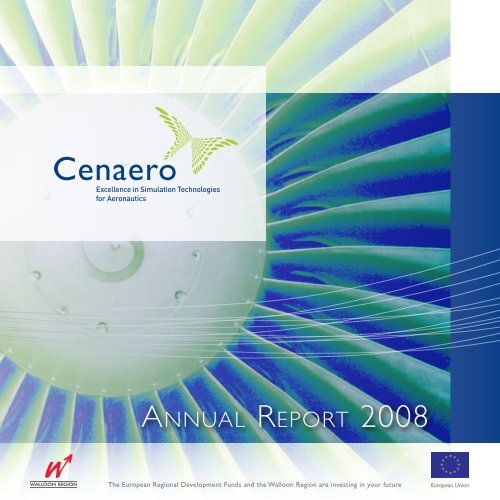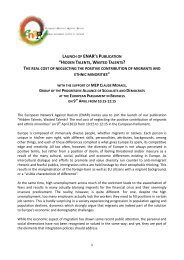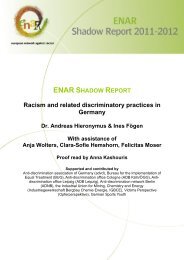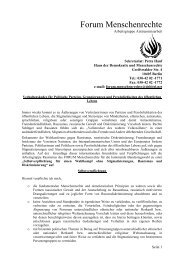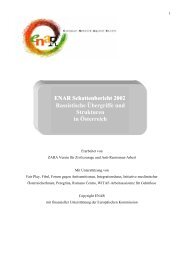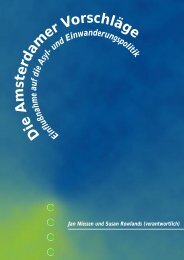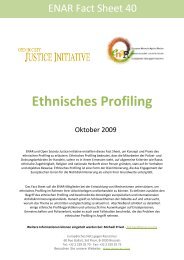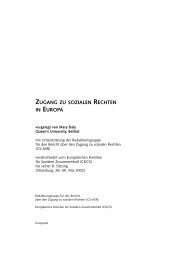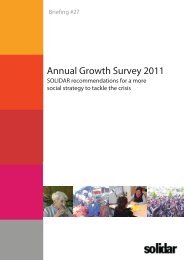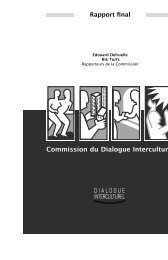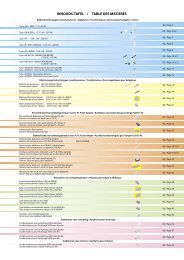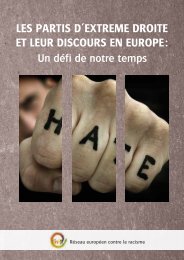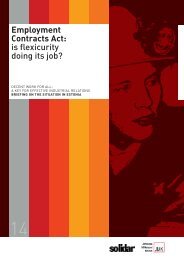AnnuAl RepoRt 2008 - Horus
AnnuAl RepoRt 2008 - Horus
AnnuAl RepoRt 2008 - Horus
You also want an ePaper? Increase the reach of your titles
YUMPU automatically turns print PDFs into web optimized ePapers that Google loves.
<strong>AnnuAl</strong> <strong>RepoRt</strong> <strong>2008</strong><br />
The European Regional Development Funds and the Walloon Region are investing in your future European Union
2 Cenaero Annual Report <strong>2008</strong> Contents<br />
Annual Report <strong>2008</strong><br />
Contents<br />
1. Word of the President 3<br />
2. Vision, Values & Strategy 4<br />
3. Highlights 5<br />
4. Governance 7<br />
Executive board 8<br />
Scientific board 9<br />
Organization chart 10<br />
5. Business Highlights with Walloon SMEs 11<br />
6. Activity Report 13<br />
a. Virtual Manufacturing 14<br />
b. Materials and Structures 18<br />
c. Fluid Mechanics 20<br />
d. Multi-disciplinary Optimization 23<br />
e. High Performance Computing 27<br />
7. Quality Management 29<br />
8. Memberships 30<br />
9. Fairs and Events 31<br />
10. R&D Projects 33<br />
11. Publications 34<br />
12. Financial Results 36<br />
13. Acronyms 39
1. Word of the President<br />
On behalf of the Board, I want to thank each and every member of Cenaero for<br />
their collective and personal accomplishments in <strong>2008</strong>, under the leadership of<br />
Michel DELANAYE, General Manager, and of the Group leaders.<br />
First and foremost, Cenaero project called SINUS has been selected by the<br />
Walloon Regional Authorities for funding by EU ERDF funds in the frame of the<br />
“Convergence” program started on July 1st, <strong>2008</strong>. This success paves the way<br />
ahead for Cenaero till 2013.<br />
Second, Cenaero has continued in <strong>2008</strong> to start new FP7 projects with major<br />
European aerospace organizations like SNECMA, AIRBUS, TECHSPACE AERO,<br />
SABCA and SAMTECH amongst others.<br />
Third, Cenaero is part of several SKYWIN R&D projects set-up in the frame of<br />
the Walloon policy for competitiveness clusters.<br />
Fourth, Cenaero has brought its techniques and technologies in numerical simulation<br />
to new sectors like transport and environment, where Cenaero now serves AGC,<br />
RENAULT, ALSTOM and smaller organisations like Greisch and Cardiatis.<br />
Word of the President<br />
Cenaero Annual Report <strong>2008</strong><br />
Finally, EU DG Regio jury selected Cenaero as one of the two Regiostars award<br />
recipients over 52 files and 17 finalists; celebration occurred on Feburary 16th,<br />
<strong>2008</strong> in presence of Jury Chairman, Mr Job Cohen, Mayor of Amsterdam, Mrs<br />
Samuta HUBNER, European Commissioner for REGIOS and Mr Rudy DEMOTTE,<br />
Walloon Region Minister President. Of course, none of these achievements could<br />
have been done without Walloon Region and ERDF financial support even if<br />
self-funding has reached 41% in <strong>2008</strong>.<br />
Cenaero remains committed to continue to serve economical development at<br />
home, in Wallonia and in Europe.<br />
3
4 Cenaero Annual Report <strong>2008</strong> 2. Vision, Values & Strategy<br />
2. Vision, Values<br />
& Strategy<br />
Cenaero is an applied research center developing methodologies<br />
and software to model complex industrial problems in applied<br />
mechanics. Cenaero vision is to become the leading reference<br />
in advanced multi-disciplinary simulation for the Aeronautics<br />
in Europe.<br />
Our values are excellence, integrity, respect and client satisfaction.<br />
By excellence, we are constantly seeking to reach the highest quality<br />
in our research and activities for our industrial clients. Integrity, we<br />
commit to deliver proven algorithmics, verified and reproducible results.<br />
We are committed to protect our environment, to ensure a fully gender<br />
equitable workplace and respect each other in our daily work.<br />
Cenaero global mission is to support the Walloon Aeronautical<br />
companies in their innovation efforts by providing them with a focused<br />
expertise in numerical methods, to enhance collaborations between<br />
universities, industry and scientific software editors, create enhanced,<br />
complementary added-value and expertise compared to currently<br />
existing regional capabilities and become a center of European level,<br />
improving European and international position of the Walloon region<br />
and Belgium in the Aeronautical sector.<br />
Cenaero maintains close relationship with universities, this is<br />
vital to constanly remain at the cutting-edge of our research themes.<br />
We favour the development of our junior personnel through doctoral<br />
studies and stimulate our senior scientists to mentor doctoral students<br />
at our partnering universities.
3. Highlights<br />
I would like to start this review of Cenaero <strong>2008</strong> highlights by underlining<br />
the excellent work performed by all teams of Cenaero.<br />
The Virtual manufacturing consulting activities have really boomed<br />
this year. Indeed, all the efforts which have been invested in the<br />
development of the Morfeo software have really paid off. Morfeo is<br />
now an industrial tool used by industry partners and clients of Cenaero.<br />
Consulting activities of the VM group have also significantly grown<br />
especially in the area of global machining modelling and welding (laser,<br />
TIG, EBW, FSW and DFW).<br />
The Extended Finite Element method is a specialized finite element<br />
technique used by MMM researchers to efficiently simulate the<br />
inclusion of cracks or defects and their propagation in metallic parts.<br />
This method has been under development in the Morfeo software<br />
for the last five years. Our researchers have shown that modelling a<br />
crack in an industrial complex geometry can be performed at least<br />
5 times faster than with any other competing technique. The level of<br />
maturity of our tools allows to model crack propagation in real complex<br />
geometries as demonstrated in many consulting activities. The Morfeo<br />
software kit including the crack modelling and propagation feature is<br />
now distributed to customers.<br />
Activities of the CFD group have been mainly focused on turbomachinery<br />
advanced aerodynamics modelling using elsA. A striking achievement is<br />
the decision of Onera to sign a partnership with Cenaero for the common<br />
development of the elsA CFD solver. This represents a recognition of the<br />
high technical capabilities of CFD researchers. Developments of high<br />
3. Highlights<br />
Cenaero Annual Report <strong>2008</strong><br />
order numerical methods in Argo have continued in close collaboration<br />
with UCL. The DGM implementation in Argo is without any doubt one<br />
of the most advanced in the world from an industrial point of view. A<br />
new PhD researcher under a First Doca project from the Walloon Region<br />
has joined the team of DGM developers.<br />
Minamo, our muldisciplinary Optimization software has demonstrated<br />
a great industrial maturity in the various projects performed in<br />
collaboration with SAFRAN subsidiaries. The Opti group is now an active<br />
member of the NATO RTB AVT-167 led by Rolls Royce aiming to bring<br />
training in the topic strategies for optimization and automated design<br />
of gas turbine engines for major aerospace turbomachinery leaders in<br />
the world.<br />
5
6 Cenaero Annual Report <strong>2008</strong> 3. Highlights<br />
In <strong>2008</strong>, Cenaero has engaged in diversifying sectors and customers.<br />
Airbus, Goodrich, Snecma space propulsion division, etc have become<br />
new customers in the Aeronautics segment. AGC, Renault, Alstom<br />
Transport have joined our expanding customer basis in the material,<br />
automotive and rail sectors. But Cenaero is also active with services<br />
to SME. Greisch and Cardiatis are among new SME customers in very<br />
diverse sectors such as building and biomedecine. We would like to<br />
emphasize the effort of the Walloon Region to set up efficient measures<br />
to enhance collaboration between research centers and SME by means of<br />
the set up the Innovation Check managed by the AST agency. Following<br />
our strategy of diversification of industry sectors, Cenaero joined in <strong>2008</strong><br />
the European Wind Energy Association (EWEA) as well as the European<br />
Turbine Network (ETN) resulting in the participation in a new European<br />
IP research project submitted to the Energy priority call and dedicated to<br />
a major strategic topic: the integrated gazeification of coal in combined<br />
cycle for the production of energy including CO 2 sequestration.<br />
In Research and Development, Cenaero continues to be very involved<br />
in many European framework program projects. Four new FP7 projects<br />
started in <strong>2008</strong>: the IP DREAM and Maaximus with major collaborations<br />
with Snecma, Techspace Aero, Airbus and Samtech and the STREP<br />
Imacpro together with Sabca, TRIADE which represents a logical<br />
extension to Cenaero project ADVICE and Lapcat II as a continuation<br />
of Lapcat. Three new projects with a contribution of Cenaero,<br />
Elubsys, Ericka and Fast20XX have been selected in the second call of<br />
priority Transport of the FP7, they should start in the course of 2009.<br />
The Cenaero project SINUS funded by the EU ERDF funds and the<br />
Walloon Region in the through the “Convergence” program started<br />
1st of July <strong>2008</strong>. SINUS is a major project enabling Cenaero to<br />
continue developing its know-how and software tools with the<br />
help of its academic partners, Sirris and Cetic. To close this section,<br />
we must emphasize the full involvement of Cenaero in the SKYWin<br />
competiveness Aeronautics pole, Cenaero will indeed take part in three<br />
new R&D projects easiPM, ICS and Multiphy. It is also worthwhile<br />
noticing the publication totaling 62 in <strong>2008</strong>.<br />
Thanks to the Walloon Region and EU ERDF funding, Cenaero invested<br />
2MEuros in software acquisition and extension of the supercomputing<br />
facilities. After a public tender, Cenaero selected Serviware and IBM to<br />
install an additional 1800 64bit Intel cores connected with an Infiniband<br />
interconnect bringing the peak capacity of Cenaero cluster to 17TFlops.<br />
With this machine, Cenaero again integrates the Top 500 list with a<br />
447th rank and is listed 85th in the world Green 500.<br />
From a financial perspective, global R&D and consulting revenues have<br />
grown by 11% with a appreciable 15% increase of consulting activities<br />
(1.36 MEuros). Direct funding from the Walloon Region has decreased<br />
by 9%. Globally, self-funding has progressed to 41.4% with a 2009<br />
target of 50% in order to eventually reach the ratio fixed by the Walloon<br />
government.<br />
Dr Michel DELANAYE<br />
General Manager
4. Governance<br />
4. Governance<br />
Cenaero Annual Report <strong>2008</strong><br />
Following its legal establishment, Cenaero is administered by an<br />
Executive Board with representatives of the members of the consortium.<br />
The Executive Board involves five companies representing the Walloon<br />
Aeronautics Association, six representatives of university members,<br />
two representatives of IGRETEC and one representative of VKI as<br />
observer. The members of the Executive Board are nominated by the<br />
General Council of the consortium members for a period of six years.<br />
The Executive Board elects its Chairman and two vice-chairmans. The<br />
Executive Board is currently chaired by M. Michel Milecan, vice-president<br />
business and strategy development at SONACA. The Excecutive Board<br />
sets up a Scientific Board for counceling on scientific matters. The<br />
Scientific Board is composed of academic and industry representatives<br />
with a majority of the latter. The Scientific Board is currently chaired by<br />
Prof. Grégoire Winckelmans of Catholic University of Louvain.<br />
7
8 Cenaero Annual Report <strong>2008</strong> 4. Governance Executive board<br />
Executive board<br />
Michel MILECAN<br />
President<br />
EWA<br />
Mario CARBONARO Institut Von Karman<br />
Alain DANGOISSE Université catholique de Louvain<br />
Gérard DEGREZ Université Libre de Bruxelles<br />
Enrico FILIPPI IGRETEC<br />
Vincent GARNIER SNECMA<br />
Pierre GUILLAUME Techspace Aero (Groupe SAFRAN)<br />
Marc HUMBLET SABCA<br />
Olivier LEONARD Université de Liège<br />
Isabelle LEFEBVRE Université Libre de Bruxelles<br />
Jean-Louis MIGEOT Free Field Technologies<br />
Michel MORANT Université de Liège<br />
Claude NYSSEN SONACA<br />
Lucyan PAPIERNIK IGRETEC<br />
Michel TILMANT SAMTECH<br />
Grégoire WINCKELMANS Université catholique de Louvain
Grégoire WINCKELMANS<br />
President<br />
Scientific board<br />
Claudine BON SAMTECH<br />
Université catholique de Louvain<br />
Jean-Pierre COYETTE Free Field Technologies<br />
Herman DECONINCK Institut Von Karman<br />
Gérard DEGREZ Université Libre de Bruxelles<br />
Enrico FILIPPI Faculté Polytechnique de Mons<br />
André GREGOIRE SONACA<br />
Robert HINNENS SABCA<br />
Stéphane MALJEAN Techspace Aero (Groupe SAFRAN)<br />
Jean POLOME Thalès Alénia Space ETCA<br />
Jean-Philippe PONTHOT Université de Liège<br />
4. Governance<br />
Cenaero Annual Report <strong>2008</strong><br />
Scientific board<br />
9
10 Cenaero Annual Report <strong>2008</strong> 4. Governance Organization chart<br />
Organization chart<br />
Laurent<br />
D’ALVISE<br />
VM Group<br />
Leader<br />
Frédéric<br />
LANI<br />
MMM Group<br />
Leader<br />
Philippe<br />
GEUZAINE<br />
CFD-MP Group<br />
Leader<br />
Executive Board<br />
Michel DELANAYE<br />
General Manager<br />
Ingrid<br />
LEPOT<br />
MDO Group<br />
Leader<br />
Michel MILECAN<br />
President<br />
Serge<br />
BOGAERTS<br />
IT & QA<br />
Group Leader<br />
Anne<br />
NAWROCKI<br />
BPM<br />
Group Leader<br />
Roger<br />
COCLE<br />
Sales & Business<br />
Development<br />
Manager
5. Business Highlights<br />
with Walloon SMEs<br />
A fruitful collaboration with Euro Heat Pipes (EHP), a SME<br />
located in Nivelles.<br />
Since 2003, EHP is positioned on the Telecom market aside major<br />
companies such as Astrium or Thales. Markets targeted by the company<br />
were initially linked to institutional satellites for ESA by providing design<br />
and supply of thermal products called heat pipes. This very competitive<br />
world market imposes to the satellites manufacturers to constantly<br />
optimize thermal controls to minimize the passive mass of the platform.<br />
This is clearly relevant, emphasizing that placing one kilogram in<br />
geostationary orbit approximately costs 100.000€.<br />
The collaboration with Cenaero has been essential for EHP for optimizing<br />
its products to meet these very severe market conditions. It would have<br />
been difficult for EHP to support all the R&D effort, so the partnership<br />
with Cenaero, initiated by both parties, rapidly showed its interest<br />
and efficiency.<br />
A legacy code developed by EHP was transmitted to Cenaero and<br />
then deeply re-engineered by centre researcher Dr Cécile Goffaux. A<br />
large amount of work for understanding and modelling of physical<br />
phenomena was required. The first exploitable and reliable versions of<br />
the code, called Hea-P, were provided after approximately three years of<br />
iterations and exchanges, which demonstrates the quality and efficiency<br />
of this partnership.<br />
5. Business Highlights with Walloon SMEs<br />
Cenaero Annual Report <strong>2008</strong><br />
Further optimization of Hea-P software, as well as its validation thanks<br />
to two experiments on board of space projects provided EHP with a<br />
critical asset to reach the Telecom market of the EUROSTAR satellites<br />
manufactured by Astrium. The first heat pipes were delivered at the<br />
beginning of year <strong>2008</strong> and EHP intend to cover 50% of the Astrium<br />
market by 2009, which is currently covered by US suppliers.<br />
11
12 Cenaero Annual Report <strong>2008</strong><br />
5. Business highlights with walloon SMEs<br />
Cenaero involves in architecture projects with Greisch,<br />
a well-known civil engineering office.<br />
The Greisch’s office, based at Liège, was founded in 1960 by the<br />
engineer and architect René Greisch and involves currently more<br />
than one hundred collaborators. One of the numerous renowned<br />
achievements of Greisch is the design and construction of the famous<br />
Millau Viaduct.<br />
In the framework of the extension of its engineering and design office,<br />
Greisch wanted to make an aero-thermal study of the air flow inside<br />
the new building due to the phenomena of convection, radiation and<br />
conduction. The new building is made of a glazed atrium composed<br />
of two floors with several offices. More specifically, Greisch wanted<br />
to estimate the temperature and the speed of the air flows in the new<br />
wing in two extreme situations (winter and summer), and also check the<br />
level of comfort for the occupants of the offices. The solar contributions<br />
on the glass roof, the opening of the doors located on the sides of the<br />
atrium as well as the various point sources of heat and/or cooling have<br />
been taken into account in the simulations.<br />
This first collaboration with Greisch was an opportunity to demonstrate<br />
the applicability of the tools developed for aeronautics applications to<br />
civil engineering and building sector problematic. This work clearly opens<br />
many potential other collaborations with Walloon and internationnal<br />
SMEs working in that field.
6. Activity Report<br />
R&T groups<br />
Cenaero involves four major R&T groups:<br />
Virtual manufacturing: the group focus is on multi-scale<br />
simulations of industrial processes like machining, welding or heat<br />
treatments. The industrial added-value is the prediction of process<br />
deformation and residual stresses.<br />
- Group name: Virtual Manufacturing (VM)<br />
- Group leader: Dr. Laurent D’Alvise<br />
Materials and structures: the group focus is on the design and<br />
integrity analysis of metallic, composite or hybrid materials and<br />
structures, as well as high performance and adaptive meshing,<br />
damage and fracture mechanics, constitutive modelling and<br />
technical-economical optimization.<br />
- Group name: Multi-scale modelling of Materials and Structures<br />
(MMM)<br />
- Group leader: Dr. Frédéric Lani<br />
6. Activity Report<br />
Cenaero Annual Report <strong>2008</strong><br />
Fluid mechanics: the group focus is on large scale industrial<br />
applications of CFD, handling of meshing and and computation<br />
of multi millions (hundreds) dof problem, modelling of complex<br />
physics (multiphase and turbulence), multi-physics (aero-acoustics,<br />
fluid-structure interaction, etc), turbomachinery aerodynamics.<br />
- Group name: CFD Multi-Physics (CFD-MP)<br />
- Group leader: Dr. Philippe Geuzaine<br />
Multi-disciplinary optimization: this group develops and uses<br />
advanced genetic algorithms accelerated with dedicated metamodels<br />
to solve complex multi-objective optimization problems in<br />
multi-disciplinary industrial environments.<br />
- Group name: Multi-Disciplinary Optimization (MDO)<br />
- Group leader: Dr. Ingrid Lepot<br />
High Performance Computing: this group supports the activities<br />
of the Research groups by managing the supercomputing and IT<br />
infrastructure of the center.<br />
- Group name: Information Technology and Quality Assurance<br />
(IT & QA)<br />
- Group leader: Ir. Serge Bogaerts<br />
13
14 Cenaero Annual Report <strong>2008</strong> 6. Activity Report a. Virtual Manufacturing<br />
a. Virtual Manufacturing<br />
Major orientations<br />
The Virtual Manufacturing group of Cenaero provides high-level<br />
engineering services and technical expertise to industries in the field<br />
of manufacturing processes simulation. The activity is dedicated<br />
to improving the quality and performance of products through<br />
simulation and optimization of the industrial processes by which they<br />
are manufactured.<br />
In <strong>2008</strong>, the key processes of the Virtual Manufacturing group have<br />
been: Friction Stir Welding, Friction Stir Spot Welding, Laser Beam<br />
Welding, TIG welding, Driven Friction Welding, machining, hot forming,<br />
heat treatments, chaining of processes, explosive forming and bird<br />
impact simulation.<br />
The aim of the numerical simulation is mainly to provide the distortions<br />
and stresses history all along the manufacturing chain which will be<br />
used for the in-service analysis. One essential expertise is then the<br />
simulation of the complete chaining between processes. This leads to<br />
the concept of virtual factory.<br />
In order to fit to this new trend, Cenaero decided in 2004 to develop<br />
from scratch a new generation manufacturing software, Morfeo<br />
(Manufacturing Oriented Finite Element tOol). The ambition is to make of<br />
Morfeo the reference in simulation of welding, machining processes and<br />
fracture mechanics for large size components and within a reasonable<br />
computation time. All efforts of the Virtual Manufacturing group at<br />
Cenaero are focused on these two categories of processes and particular<br />
attention is paid to the industrial functionalities of the software.<br />
Within the DEEPWELD project (FP6), Morfeo has been validated based<br />
on industrial instrumented applications to become the leading standalone<br />
solid-state welding software, capable of simulating industrially<br />
the whole Friction Stir Welding process.<br />
Within the VERDI project (FP6) and in collaboration with Techspace Aero<br />
(Safran Group), Morfeo has been validated on industrial instrumented<br />
applications to become the leading stand-alone multi-physics and<br />
multi-scale fusion welding software, capable of simulating industrially<br />
the whole Electron Beam Welding process.<br />
Within several consultancy services for Snecma (Safran Group), the<br />
capabilities of Morfeo in machining were used for the design of new<br />
aeroengines components, hence becoming the leading stand-alone<br />
machining software, capable of simulating industrially the effect of<br />
removing material on the distorsions.<br />
Within consultancy services and short-term projects for AIRBUS,<br />
ALSTOM Transport, MESSIER-DOWTY UK, RENAULT and SAPA, Morfeo<br />
and the expertise of the Virtual Manufacturing Group were used in the<br />
optimization of processes.<br />
Finally, Morfeo commercialization began with the sales of licences to<br />
KTH (SCANIA application) and SNECMA (Safran Group).
Industrial applications<br />
a. Virtual Manufacturing<br />
Relaxation of residual stresses during multi-pass machining<br />
simulation with Morfeo and process optimization<br />
One of the major difficulties of the machining process is to control<br />
the final shape which can deviate from the nominal one. Among the<br />
main sources of distortions, one can cite relaxation of residual stresses<br />
generated during an upstream process, cutting forces introduced<br />
during machining, efforts due to the fixation system and chattering. In<br />
many cases, and especially when dealing with heavy workpieces, initial<br />
residual stresses is the major source.<br />
Mesh initial workpiece Initial stress state Initial geometry<br />
and 2 cutting paths<br />
Different length scales might be considered to model these phenomena.<br />
Typically, a local one to the tool tip is needed to take into account<br />
cutting forces and chattering. On the other hand, the workpiece can be<br />
considered in a whole when dealing with initial stress relaxation. This<br />
contribution focuses on the latter and ends with a coupling between<br />
different effects.<br />
6. Activity Report<br />
Cenaero Annual Report <strong>2008</strong><br />
Initial residual stresses are generated during previous operations such as<br />
forging and/or heat treatments. However, during machining operations,<br />
these are relaxed and lead to undesired distortions which can be out<br />
of tolerance bounds. Numerical prediction of this effect is thus very<br />
important so that a better approach can be proposed (e.g.: cutting paths<br />
modification, changing the operations sequence...).<br />
Machined workpiece<br />
and stress state<br />
15
16 Cenaero Annual Report <strong>2008</strong> 6. Activity Report a. Virtual Manufacturing<br />
Dealing with only the global scale enables to handle complex threedimensional<br />
industrial applications. When dealing with multi-pass<br />
machining applications, using classical finite element simulations will<br />
lead to some limitations. Typically, cutting paths are given by numerical<br />
commands of the machine so that they are always defined in an initial<br />
configuration. On the other hand, the workpiece is being distorted<br />
between each pass; that is why finishing passes are used in order to<br />
reduce the importance of previous distortions. Of course, such important<br />
effect must be taken into account in the model which prevents using a<br />
workpiece mesh that matches the cutting paths beforehand, given the<br />
fact that they would be deformed. A remeshing step is then needed after<br />
each pass in order to correctly take into account this new path. This is<br />
far from being flexible and defining the workpiece mesh completely<br />
independently of the cutting paths is one of the goals of this project.<br />
In order to circumvent these limitations, an innovative approach based<br />
on the level-set method has been developed within the Cenaero inhouse<br />
software Morfeo (Manufacturing ORiented Finite Element tOol)<br />
in order to define cutting paths independently of the workpiece mesh.<br />
Moreover, an automated process optimization loop has been tested<br />
in order to improve the final shape in terms of various geometrical<br />
parameters, such as the position of the final piece within the raw<br />
material or the cutting paths geometry.<br />
Computing temperature cycles in FSW using a combined<br />
thermo-fluid and thermo-mechanical finite element model<br />
in Morfeo<br />
The correct computation of temperature cycles is a necessary step towards<br />
the prediction of the microstructural evolution during welding, the<br />
resulting mechanical properties as well as the residual stress distribution<br />
in a Friction Stir Welded joint. Currently most numerical models rely on<br />
the measurements of the energy consumption or heat input to be used<br />
as input data into a thermo-mechanical Finite Element numerical model,<br />
which means that these models are not fully predictive.<br />
Cenaero combines a thermo-fluid and thermo-mechanical Finite Element<br />
models to overcome this problem. The three-dimensional thermo-fluid<br />
model is used to predict the heat generation and temperature field<br />
around a FSW tool. The plastic work calculated from the flow simulation<br />
is used as a heat source in the thermal calculation. This heat source<br />
is then transferred to the thermo-mechanical simulation. Experimental<br />
input data regarding the heat source is therefore no longer required in<br />
this modelling approach.<br />
Simulation results are presented in terms of resulting heat sources<br />
and temperature fields. They are compared to experimental data:<br />
thermocouple measurements in the welded joint, backing plate and<br />
tool. The experiments were performed on AA2024 T351 sheets. The<br />
model is validated for a range of operating parameters and two sheet<br />
thicknesses. The results of the thermo-fluid and thermo-mechanical<br />
models are very similar and in good agreement with measured<br />
temperatures. All calculations are performed using Morfeo.
The method of local/global coupling implemented in Morfeo is<br />
presented as follows:<br />
Global model<br />
(Morfeo thermo-mechanical computation)<br />
a. Virtual Manufacturing<br />
Local model<br />
(Morfeo thermo-fluid computation)<br />
Morfeo was implemented some specific capabilities for the prediction<br />
of the microstructure. Calculation and validation of the hardness<br />
profile after natural ageing is shown as follows:<br />
6. Activity Report<br />
Cenaero Annual Report <strong>2008</strong><br />
17
18 Cenaero Annual Report <strong>2008</strong> 6. Activity Report b. Materials and Structures<br />
b. Materials and Structures<br />
Major orientations<br />
In <strong>2008</strong>, the MMM group further developed its key expertise in three<br />
main research areas in Applied Mechanics.<br />
In the frame of the FEDER project Sinus, the group carried on with<br />
the improvement of its implementation of the eXtended Finite Element<br />
Method (XFEM) for its application to damage tolerant analyses and<br />
3D crack propagation simulations in aerostructures, equipments<br />
and aeroengine components. Numerous consultancy studies were<br />
successfully completed for international customers with the help of the<br />
in-house XFE module Morfeo/Crack. Much work has also been done in<br />
order to bring the latter to the standards of robust industrial software.<br />
The first commercial release of Morfeo/Crack is expected by mid-2009.<br />
In the frame of regional and European projects such as APC, IMAC-<br />
Pro and Maaximus, significant efforts were invested in implementing,<br />
applying and combining leading edge methodologies in structural<br />
design, analysis and optimization of multi-material and composite<br />
structures. In particular, the group demonstrated its ability to treat<br />
complex multi-physics (static and dynamic stress analysis, random<br />
vibrations, shock, thermal-mechanical coupling, etc) industrial problems<br />
thanks to in-house automated CAD/CAE chains, piloted by Cenaero’s<br />
state-of-the-art optimizer Minamo. More particularly, excellent<br />
progress has been made in the optimization of draping sequences and<br />
in the minimization of manufacturing costs through efficient coupling<br />
of Catia CPD, Abaqus CAE, Simulayt, SEER-DFM and Minamo. Besides,<br />
in the FP6 project ADVICE which aims at detecting and characterizing<br />
damage in composites through the simulation of the propagation<br />
of Lamb waves and the use of pattern recognition algorithms, the<br />
developments of the MMM group are about to be integrated as part of<br />
an experimental validation set-up, which is an important milestone in<br />
the development of Cenaero’s Structural Health Monitoring activities.<br />
A workshop dedicated to the presentation of the outputs of ADVICE<br />
will be organized at the SMART’09 conference in Lisbon. Year 2009 will<br />
also see the start of a new, promising activity, namely the modelling of<br />
manufacturing processes for composite structures as part of the Easi-<br />
PM and Triade projects. Finally, <strong>2008</strong> has brought much satisfaction<br />
in the field of modelling of adhesively bonded structures, with both<br />
industrial activities for international customers and state-of-the-art<br />
research leading to a far better understanding of the local mechanical<br />
behaviour of bonded joints.<br />
Last but not least, the group continued the development of numerical<br />
methods aiming at improving the accuracy of FE simulations both in the<br />
linear and non-linear regime. This includes cutting-edge developments<br />
in the FETI method for multi-processors simulations which led to<br />
remarkable speed-ups on Cenaero’s HPC platform when addressing<br />
complex FE models of aerostructures (eg in the MUSCA and Maaximus<br />
projects). In addition to this, the MMM group further studied specific<br />
error indicators for fracture mechanics problems solved with the XFEM.<br />
Finally, in <strong>2008</strong>, the MMM group also tackled the problem of mesh<br />
refinement methodologies for problems including geometrical as well as<br />
material non-linearity, treated in a commercial CAD/CAE framework.
Industrial applications<br />
The commercial XFE software package<br />
b. Materials and Structures<br />
In the frame of the FEDER project Sinus, the MMM group continues the<br />
developments initiated in the previous programme, aiming at simulating<br />
the propagation of 3D cracks using the XFEM. Cenaero’s methodology<br />
has been shown to be most cost-efficient (the number of manual<br />
operations and labour time has been decreased by a factor of more than<br />
5), most robust (due to its unique ability to treat properly the update of<br />
Automated propagation of a 3D crack in a hollow cylinder submitted to inner cyclic pressure.<br />
The crack propagates from the right to the left. It approaches the left hole without<br />
effectively touching it on the outer surface of the cylinder (see picture on the left), while it<br />
actually crosses the left hole boundary on the inner surface of the cylinder (see picture on<br />
the right). This demonstrates the peculiar ability of the method to treat major topological<br />
changes without manual intervention.<br />
level sets along with crack propagation) and most accurate (eg: thanks<br />
to dedicated mesh refinement, parallel computation and convergence<br />
studies both at the local and global scale). This methodology will soon<br />
be available in a commercial XFE software package called Morfeo/<br />
Crack. The efficiency of the method has been demonstrated in the frame<br />
of advanced consultancy studies for renowned customers including<br />
Techspace-Aero, Sonaca, Snecma DMS, Snecma DMA and Goodrich AS.<br />
6. Activity Report<br />
Virtual testing for composite structures<br />
Cenaero Annual Report <strong>2008</strong><br />
The effort dedicated to research in the field of composite structures is<br />
continuously growing at Cenaero. One of the research topics of this<br />
area sets the focus on the development of systems able to detect and<br />
quantify damage in composite structures. Cenaero’s contribution is here<br />
essential thanks to the virtual testing capabilities of the MMM group.<br />
Simulation of propagating waves in thin composite structures leads to<br />
virtual signals that contain all the necessary information about their<br />
Occurrence of ply failure / delamination in composite structures<br />
is detected through signal change of guided waves and accurate pattern recognition<br />
algorithms based on neural networks (ADVICE project).<br />
possibly damaged or undamaged state. Robust and accurate numerical<br />
methods and methodologies, along with specific signal treatment and<br />
pattern recognition algorithms, help calibrating a software module that<br />
will be integrated in an experimental validation set-up. In this framework,<br />
it is interesting to point out the pioneering work of the partners of the<br />
ADVICE project regarding the development of self-powered damage<br />
detection and vibration damping systems. The end of the ADVICE project<br />
is planned in October 2009, with the demonstration of the developed<br />
technologies on a sample stiffened composite panel.<br />
19
20 Cenaero Annual Report <strong>2008</strong> 6. Activity Report c. Fluid Mechanics<br />
c. Fluid Mechanics<br />
Major orientations<br />
The CFD-Multiphysics Group has been involved in three major research<br />
projects during <strong>2008</strong>. Related to the Cenaero/SAFRAN partnership,<br />
the first project is oriented towards the simulation of turbomachinery<br />
flows with the elsA software developed at Onera. Numerous advanced<br />
simulations have been performed including technological effects and<br />
secondary flows for low pressure compressors, real geometry effects<br />
for low pressure compressors and turbines as well as unsteady flows<br />
for low pressure compressors. In addition, work has been continued<br />
in the fields of computational chain design and validation. Finally, the<br />
signature of a partnership with Onera paves the way for developments<br />
within elsA in 2009 in order to further broaden the application range<br />
in turbomachinery flows.<br />
The second project is focused on the simulation of complex<br />
aerodynamics and aero-acoustics problems through the development of<br />
Argo, a in-house unstructured finite volume and finite element solver.<br />
The backbone of this project is the accurate simulation of turbulent<br />
flows for which a LES-type approach is followed. The solution of aeroacoustics<br />
problems relies on an acoustic analogy in which Argo is<br />
coupled to a commercial acoustic solver. While Argo has been further<br />
validated during <strong>2008</strong> through the computation of many industrial<br />
flow problems, developments have been pursued in the field of higher<br />
order discretizations based on the discontinuous Galerkin finite element<br />
method. These developments will be continued in order to apply them<br />
to the solution of RANS problems. An advanced temporal aero-acoustic<br />
coupling will also be a research topic in 2009.<br />
Finally, the third project aims at advanced multi-phase flow simulations<br />
involving one-dimensional modelling in a system simulation software<br />
as well as in Hea-P, a in-house thermo-hydraulic solver for the design<br />
of heat pipes. In addition to these topics, research will be conducted in<br />
2009 for the three-dimensional modelling within Argo of lubrification<br />
systems related to aero engines.
Industrial applications<br />
Seal leakage flow simulations for a highly loaded<br />
low pressure compressor<br />
c. Fluid Mechanics<br />
As turbofan engines have to meet ever more drastic economical and<br />
environmental requirements, new engine architectures need to be<br />
developed. An architecture with high potential in terms of reducing<br />
the perceived noise and fuel burn emissions is the counter-rotating<br />
turbofan engine. It is currently investigated in the frame of the FP6 VITAL<br />
project. Because of the higher loading of the low pressure compressor,<br />
it is mandatory to quantify the effectiveness of labyrinth seals and the<br />
impact of interaction of the hub leakage flow with the main stream.<br />
Based on a design by Techspace Aero and the von Karman Institute of<br />
a representative single stage highly loaded low pressure compressor,<br />
Cenaero has performed advanced simulations with the elsA software<br />
of the labyrinth seal leakage flow with its complete geometry being<br />
taken into account (see Fig. 1). This allowed to identify the amount of<br />
mass flow that recirculates and to assess the impact on the secondary<br />
flow structures and on the radial distributions. Figure 2 illustrates the<br />
streamlines in an azimuthal cut of the labyrinth. The experimental and<br />
numerical results, obtained respectively by the von Karman Institute and<br />
Cenaero, will be correlated in 2009.<br />
6. Activity Report<br />
Fig. 2<br />
Cenaero Annual Report <strong>2008</strong><br />
Fig. 1<br />
21
22 Cenaero Annual Report <strong>2008</strong> 6. Activity Report c. Fluid Mechanics<br />
Fig. 1<br />
Nacelle flow simulations for a tilt-rotor configuration<br />
It is expected that tilt-rotor aircrafts (see Fig. 1) will play an important<br />
role in future regional transport due to their particular characteristics,<br />
combining the advantages of a helicopter vertical and hover capabilities<br />
with those of a fixed-wing aircraft cruise speed and range. Prototypes<br />
are currently developed within the FP6 NICETRIP project that aims to<br />
develop and validate new technologies for tilt-rotor aircrafts. Within<br />
this project and in collaboration with Eurocopter, Agusta and the<br />
University of Liège, Cenaero has performed advanced simulations with<br />
its in-house Argo solver of the flow around (see Fig. 2) and within (see<br />
Fig. 3) the nacelle at cruise conditions. The goal of these simulations is<br />
to quantify the flow distortions at the compressor inlet plane and to<br />
verify if the engine installation criteria and performance are fulfilled.<br />
These numerical results will be correlated with wind tunnel experiments<br />
performed at the University of Liège in 2009.<br />
Fig. 2<br />
Fig. 3
d. Multi-disciplinary Optimization<br />
Major orientations<br />
d. Multi-disciplinary Optimization<br />
Along the year <strong>2008</strong>, the activities of the numerical methods and<br />
multi-disciplinary optimization group have grown and focused on<br />
the development and exploitation of Cenaero’s in-house optimization<br />
platform Minamo, implementing surrogate model accelerated single<br />
and multiple objective evolutionary strategies. Shape parameterization,<br />
direct native CAD access and automatic meshing tools were<br />
continuously developed and enriched in order to support Minamo in<br />
solving increasingly challenging multi-disciplinary problems, with a<br />
CAPRI based client-server automatic bi-directional CAD interface. The<br />
year <strong>2008</strong> has been a year of both numerous new developments and<br />
consolidation in terms of applications as it has seen the optimization<br />
platform applied to increasingly complex large-scale multi-disciplinary<br />
industrial problems, essentially in the field of turbomachinery design<br />
within the framework of the Cenaero/SAFRAN partnership.<br />
In terms of developments, let us mention a series of major enhanced<br />
capabilities in terms of sampling (auto-adaptive Centroidal Voronoï<br />
tessellations), surrogate modelling (auto-adaptation of Radial<br />
Basis Functions networks, Kriging variants, models combinations)<br />
and optimization algorithms (surrogate based hybrid evolutionary<br />
strategies/gradient-based techniques). Further essential development<br />
axes in order to tackle increasingly complex and computationally<br />
6. Activity Report<br />
Cenaero Annual Report <strong>2008</strong><br />
demanding optimization tasks will include a.o. enhancement of meta-<br />
modelling and multi-objective multi-fidelity capabilities to be assessed<br />
in the frame of robust design activities.<br />
Optimization being by nature tranverse to all engineering disciplines and<br />
beyond the recognized expertise of the group in the turbomachinery<br />
field to be further consolidated, a major aim for 2009 will also be<br />
application sector diversification.<br />
In <strong>2008</strong>, the group has successfully integrated the FP7 LAPCAT II,<br />
FAST20XX and DREAM projects. This takes up to 7 the number of<br />
European research projects of the 6th and 7th Framework Programs<br />
in which the group took part along <strong>2008</strong>, with challenging and varied<br />
contributions e.g. ranging from the aero-acoustic optimization of open<br />
rotor configurations in the frame of DREAM to the optimization of<br />
a generic joint shear test apparatus in the FP6 MUSCA project.<br />
Clearly aiming for activity sector diversification, challenging contributions<br />
to the FP7 H2-IGCC project, dedicated to the develop ment of reliable lowemission<br />
technologies for synthetic fuel gases combustion now accepted<br />
for negotiation with the EC and to the Win-TPS project (Walloon region),<br />
dedicated to the development of a hadron therapy planning software for<br />
cancer treatment have also been set up.<br />
23
24 Cenaero Annual Report <strong>2008</strong> 6. Activity Report d. Multi-disciplinary Optimization<br />
Industrial applications<br />
The year <strong>2008</strong> has seen the application of Minamo to complex multidisciplinary<br />
industrial problems, whether in the frame of European<br />
projects or industrial programs. More specifically, numerous consulting<br />
projects have been successfully conducted, essentially in the field of<br />
turbomachinery design, including aerodynamic, mechanical and aeromechanical<br />
optimizations of both bladings and endwalls. An essential<br />
leap forward in terms of applications has also been achieved towards<br />
technological and real geometry effects handling integration in the<br />
design process. Two industrial examples illustrating the exploitation of<br />
Minamo’s capabilities are presented hereafter. The first one is related to<br />
the FP6 LAPCAT project (Long-Term Advanced Propulsion Concepts and<br />
Technologies), which evaluated different high speed vehicles capable of<br />
achieving the ultimate goal to reduce antipodal flight times to less than<br />
2 to 4 hours. The second example illustrates Cenaero’s contribution to<br />
the FP6 NEWAC project (NEW Aero engine Core concepts), targeting the<br />
development of alternative engine configurations in order to achieve<br />
significant and durable reduction of pollution.<br />
Simulation-based stochastic sensitivity analysis of Mach 4<br />
mixed-compression intake for a variable-cycle Turbine-Based<br />
Combined Cycle (TBCC) engine:<br />
The studied intake, illustrated in Fig. 1, consists of two movable external<br />
compression ramps followed by an isolator section with bleed channel.<br />
The compressed air is then diffused through a rectangular-to-circular<br />
subsonic diffuser. While RANS simulation (see Fig. 2) of the nominal<br />
intake configuration provides more realistic performance characteristics<br />
of the intake than the cycle analysis program, the intake design<br />
should also take into account in-flight uncertainties for robust intake<br />
performance. Exploiting Minamo and its quantitative variance analysis<br />
(ANOVA) module, Cenaero focused on the effects of the geometric<br />
uncertainties on pressure recovery and mass capture fraction. Following<br />
the construction of a light-weight analytical model, more precisely a<br />
radial basis functions (RBF) network trained via adaptively sampled<br />
RANS simulation results, stochastic sensitivity analysis was performed<br />
by means of an ANOVA technique based on a Sobol decomposition.<br />
Such an approach offers a generalized multi-input-multi-output<br />
sensitivity analysis based on high-fidelity RANS simulations and the<br />
resulting Sobol’s influence indices (see Fig. 3) allow the engineer to<br />
identify dominant parameters as well as the degree of interaction<br />
among multiple parameters, then to be fed back into the design cycle.<br />
References:<br />
Preliminary Definition of a TBCC Propulsion System for a Mach 4.5 Supersonic<br />
Cruise Airliner<br />
M. Sippel, K. Okai, H. Kato, and A. Kumar, 18th International Symposium on Air Breathing<br />
Engines (ISABE), Septembre 2007, Beijing, China.<br />
Simulation-based Stochastic Sensitivity Analysis of a Mach 4.5<br />
Mixed-compression Intake<br />
H. Kato, K. Ito, 6th European Symposium on Aerothermodynamics for Space Vehicles,<br />
November <strong>2008</strong>, Versailles, France.
Fig. 2<br />
Mach 4 mixed-compression<br />
intake Mach number<br />
contours<br />
Fig. 1<br />
Mach 4 mixed-compression<br />
intake design – parameters:<br />
movable ramps, cowl and isolator wall<br />
deflections<br />
Measurement<br />
plane<br />
d. Multi-disciplinary Optimization<br />
RAMP2_D<br />
2nd order<br />
RAMP3_D<br />
Fig. 3<br />
1 st order ANOVA sensitivies:<br />
isolator floor and ceiling perturbation<br />
appear dominant for pressure recovery<br />
6. Activity Report<br />
COWL1_D<br />
Cenaero Annual Report <strong>2008</strong><br />
TotalPressure<br />
COWL2_D<br />
ISOLATOR_D<br />
25
26 Cenaero Annual Report <strong>2008</strong> 6. Activity Report d. Multi-disciplinary Optimization<br />
High pressure compressor rotor blade and 3D endwall<br />
design accouting for real geometry effects<br />
In partnership with Snecma, Cenaero’s contribution focused on the<br />
improvement of the efficiency and extension of the stall margin of<br />
a high pressure compressor. To this end, Cenaero performed both<br />
multi-point blade shape and 3D endwalls optimizations based on<br />
3D RANS simulations trough direct and native access to the CATIA<br />
v5 parameterization. More precisely, through adequate 3D profiling,<br />
two different design families, illustrating the ability of evolutionary<br />
strategies to globally search the conception space to possibly offer<br />
a panel of solutions to the designer, were identified that allowed a<br />
0.4% gain in isentropic efficiency while preserving stability. Detailed<br />
investigation of the flow features showed that, for all the 3D promising<br />
designs identified, the non axisymmetric hub influenced more the<br />
shock mechanism close to the wall rather than the secondary flows<br />
(see Fig. 4).<br />
However, since modifications of the endwalls are quite local, their<br />
impact should be assessed in presence of real geometry effects such<br />
as fillets. CAD and mesh generation are key players in the development<br />
of a design methodology. Both complete fillet modelling (with bitangency<br />
condition) and truncated fillet constructions easier and<br />
cheaper to mesh have been developed (see Fig. 5), with focus on the<br />
mandatory issue of robustness, as heavily non axisymmetric platforms<br />
are to be considered. These developments allowed preliminary results to<br />
assess the impact of the fillet on the 3D contouring isentropic efficiency<br />
gains while, one step further, the truncated fillet modellings developed<br />
pave the way for conjoint blade and endwall(s) conception including the<br />
fillet in a cost efficient way.<br />
3D contoured case Axisymmetric reference<br />
Fig. 4 Relative Mach number in the blade-to-blade plane at 11% span,<br />
highlighting the reduced wake and the decrease of the Mach number<br />
downstream the shock, in the region of flow acceleration for the optimized hub<br />
Fig. 5 Truncated (left) and complete (bi-tangency) fillet modelling robust to<br />
heavy parametric 3D platform variations<br />
References:<br />
Design Optimization of a HP Compressor Blade and its Hub Endwall<br />
V. Iliopoulou, I. Lepot and P. Geuzaine, ASME Turbo Expo <strong>2008</strong>, GT<strong>2008</strong>-50293, June <strong>2008</strong>,<br />
Berlin, Germany.<br />
Multi-point non axisymmetric endwall optimization applied to a High Pressure<br />
Compressor Rotor Blade<br />
V. Iliopoulou, T.Mengistu, I. Lepot, 12th AIAA/ISSMO Multi-disciplinary Analysis<br />
and Optimization Conference, September <strong>2008</strong>, Victoria, British Columbia, Canada.
e. High Performance Computing<br />
Major orientations<br />
e. High Performance Computing<br />
In order to support the development of its activities in advanced numerical<br />
simulations, Cenaero invested in high performance computing facilities<br />
soon after its creation and the research center counts now several years<br />
of experience in operating such supercomputers. Providing access to<br />
appropriate computing resources and efficient operation of these is one<br />
of the most essential missions of the IT & QA Support group.<br />
The corresponding activities start with the follow up of the solutions<br />
available on the market, their selection and sizing in relation to the<br />
different research topics. Hosting of these supercomputers is then also<br />
a significant concern for the group as it requires the set up of a data<br />
center capable of managing these machines, large electrical power<br />
consumers and heat generators. Cenaero operates since some years<br />
an efficient data center providing both a reliable and environmentalfriendly<br />
infrastructure: thanks to redundant chilled-water-based air<br />
conditioning systems, cooling of the data center is secured while<br />
minimizing the energy consumption taking benefit as much as possible<br />
from low atmospheric temperature conditions. We also aim at studying<br />
how applications developed at Cenaero can take the best out of the<br />
selected computer architecture thanks e.g. to the selection and usage<br />
of appropriate development tools or to the implementation of coding<br />
techniques allowing to release application bottlenecks. Collaborative<br />
exploitation of computational resources is also the subject of activities<br />
in the group. Integration of environments or applications in a grid<br />
6. Activity Report<br />
Cenaero Annual Report <strong>2008</strong><br />
computing framework, allowing users to take full and transparent<br />
advantage of multiple resources or remote and distributed postprocessing<br />
of large data sets being generated on supercomputers are<br />
examples of such activities.<br />
As done already 2 years before, we launched this year a public<br />
procurement to perform a new upgrade of our distributed memory<br />
supercomputer named ernest. Besides a computing power upgrade,<br />
this tender targeted the supply of compute nodes suited for memory<br />
demanding computations – typically those coming from structural<br />
mechanics problems – as well as an additional storage solution<br />
required to be both tolerant to component failures and able to cope<br />
with computations involving input-output-intensive operations. The<br />
selected solution based on IBM hardware was provided by Serviware.<br />
The upgraded cluster counts more than 2000 processing units (cores) and<br />
ranked 447 in the Top500 list issued in June <strong>2008</strong>. It provides a storage<br />
capacity of more than 20 TB, a third of it being supplied by the high<br />
performance and reliable GPFS system.<br />
As part of the new SINUS project, we also prepared the extension of the<br />
data center. In order to host the supercomputer to be procured in the<br />
framework of this new research project, an extension of the data center<br />
targeting a factor 3 hosting capacity increase is indeed planned for the<br />
coming year.<br />
27
28 Cenaero Annual Report <strong>2008</strong> 6. Activity Report e. High Performance Computing<br />
Industrial applications<br />
Amongst Cenaero industrial partners, Techspace Aero has been relying<br />
upon the center expertise in numerical simulation for many years.<br />
Developping together methodologies for advanced simulation of flows<br />
in low pressure compressors, both Cenaero and Techspace Aero have<br />
jointly decided to perform such simulations on distributed memory<br />
supercomputers.<br />
Considering Cenaero expertise and knowledge in distributed computing<br />
environment, Techspace Aero requested from Cenaero access to<br />
computational resources suited for its needs. The corresponding<br />
equipment was procured and integrated to Cenaero computing<br />
environment while being securely dedicated to the corresponding<br />
business. As part of the project, a customized execution environment<br />
was set up. Techspace Aero design engineers can now seemlessly<br />
submit computations to Cenaero computational system. Their jobs and<br />
associated data are transparently transferred to Cenaero, adapted to the<br />
distributed environment and executed on the supercomputer. Resulting<br />
data are automatically and securely returned to the client site for use<br />
within their design environment.<br />
Focusing on operation continuity and building upon the reliability of<br />
its infrastructures, Cenaero is providing computing resources with a<br />
maximized availability suited to industrial requirements. Cenaero support<br />
team ensures in addition a great reactivity on Techspace Aero requests<br />
both in normal (operational) or incidental situations.
7. Quality<br />
Management<br />
7. Quality Management<br />
Cenaero Annual Report <strong>2008</strong><br />
In line with the strive for excellence and seeking our customer<br />
satisfaction, the implementation and follow up of a quality management<br />
system (QMS) is strategic to our research center. The IT & QA Support<br />
group is in charge of the evaluation, implementation and follow up of<br />
this process. The objective is to set up a management system providing<br />
the researchers with organizational tools allowing them to focus on the<br />
creative part of their function while ensuring quality of our products, i.e.<br />
products answering our customers’ requirements.<br />
The commitment to permanently improve our customers satisfaction – in<br />
particular those of the aeronautical industry – is now being transposed<br />
in a quality management system complying with the EN 9100 standard<br />
of the aeronautical industry. The certification of our QMS is planned for<br />
the coming year.<br />
Meanwhile, the quality requirements of our clients are taken into<br />
account operationally within the projects execution, starting with<br />
the intellectual services supplied to the SAFRAN group. In the latter<br />
framework, the quality of Cenaero services is systematically evaluated<br />
at delivery time resulting in a mark in the range 0-10. This measure of<br />
Cenaero’s performance is the subject of periodic reviews with the client<br />
quality department: a mark of higher than 8.2 on average over <strong>2008</strong> is<br />
the evidence of a quality of service beyond expectations as compliant<br />
suppliers obtain marks not greater than 7.5. This valuable achievement<br />
encourages us to secure this level of performance reflecting our good<br />
practices and experience of our client requirements into our QMS.<br />
29
30 Cenaero Annual Report <strong>2008</strong> 8. Memberships<br />
8. Memberships<br />
Very active within the regional and international research networks,<br />
but also within industrial and professional networks, Cenaero is active<br />
member of several professionnal associations.<br />
Accord Wallonie: Cenaero is a member of Accord<br />
Wallonie, the association of the research centers<br />
of the Walloon Region.<br />
http://www.accord-wallonie.be<br />
Agoria: Cenaero is also member of Agoria, the<br />
association gathering all the Belgian technology<br />
industries.<br />
http://www.agoria.be<br />
Through its participation to numerous research projects, Cenaero<br />
meets and collaborates with other research centers of the region.<br />
Cenaero is operating its High Performance Computing (HPC) facilities in<br />
collaboration with CETIC, the Walloon research centre for ICT.<br />
http://www.cetic.be<br />
Cenaero was an active member throughout the year <strong>2008</strong><br />
of the following networks:<br />
Aerospace competitiveness pole Skywin<br />
http://www.skywin.be<br />
Cluster Auto-mobilité<br />
http://clusters.wallonie.be/automobilite/en<br />
Cluster des Entreprises Wallonnes de<br />
l’Aéronautique - EWA<br />
http://www.ewa.be<br />
Cluster Tweed - Technologie Wallonne Energie-<br />
Environnement et Développement durable<br />
http://www.clustertweed.be<br />
Cluster Mitech - Micro-Technologies<br />
for Intelligent Manufacturing & Products<br />
http://clusters.wallonie.be/mitech<br />
Cenaero is also member of international industrial networks, like:<br />
Ter@tec , the French association<br />
promoting the intensive use and sharing<br />
knowledge of supercomputers in Europe.<br />
http://www.teratec.fr<br />
In <strong>2008</strong>, Cenaero also became member of :<br />
ETN – European Turbine Network .<br />
ETN represents gas turbine technology<br />
community for power generation,<br />
mechanical drive and marine applications.<br />
http://www.eu-gasturbine.org<br />
EWEA - European Wind Energy Association.<br />
EWEA is the voice of the wind industry,<br />
actively promoting the use of wind<br />
power in Europe and worldwide.<br />
http://www.ewea.org
9. Fairs and Events<br />
During <strong>2008</strong>, Cenaero participated to many fairs and events in order to<br />
promote its technologies and software. Here follows a non exhaustive list<br />
of meetings where Cenaero was present:<br />
Aero Engine Expo (Paris, FR)<br />
Aeromart (Toulouse, FR)<br />
Aerospace and Defense (Torino, IT)<br />
CréaWal (Louvain-la-Neuve, BE)<br />
EWEC <strong>2008</strong> (Bruxelles, BE)<br />
Farnborough Airshow (Farnborough, EN)<br />
ILA Berlin (Berlin, DE)<br />
Industrie Paris (Paris, FR)<br />
JEC Composites Show (Paris, FR)<br />
SIA Robust Design (Paris, FR)<br />
Space Days (Liège, BE)<br />
9. Fairs and Events<br />
Cenaero Annual Report <strong>2008</strong><br />
Technology watch, scientific presentations and communications are<br />
an important activity for maintaining our technical excellence, our<br />
researchers attended numerous scientific meetings during <strong>2008</strong>:<br />
14th AIAA/CEAS Aeroacoustics Conference, May 5-7 <strong>2008</strong>,<br />
Vancouver, Canada<br />
ACOMEN, May 26-28 <strong>2008</strong>, Liège, Belgium<br />
International Workshop on Fundamental Issues Related to<br />
Aircraft Trailing Wakes May 27-29 <strong>2008</strong>, Marseille, France<br />
SFT <strong>2008</strong> Thermique Aéronautique et Spatiale,<br />
June 3-6 <strong>2008</strong>, Toulouse, France<br />
7th International ERCOFTAC Symposium on Engineering<br />
Turbulence Modelling and Measurements, June 4-6 <strong>2008</strong>,<br />
Limasol, Cyprus<br />
ASME Turbo Expo <strong>2008</strong>, June 9-13 <strong>2008</strong>, Berlin, Germany<br />
6th International conference on nanochannels,<br />
microchannels and minichannels, June 23-25 <strong>2008</strong>,<br />
Darmstadt, Germany<br />
WCCM8 & ECCOMAS <strong>2008</strong>, June 30 - July 5 <strong>2008</strong>,<br />
Venice, Italy<br />
The 4th International Gas Turbine Conference The Future<br />
of Gas Turbine Technology, October 15-16 <strong>2008</strong>,<br />
Brussels, Belgium<br />
31
32 Cenaero Annual Report <strong>2008</strong> 9. Fairs and Events<br />
43ème Colloque d’aérodynamique appliquée de l’AAAF,<br />
March 10-12 <strong>2008</strong>, Poitiers, France<br />
9th MpCCI User’s Forum <strong>2008</strong>, Feb 19-20 <strong>2008</strong>, Sankt<br />
Augustin, Germany<br />
3rd OpenFOAM Workshop, July 9-11 <strong>2008</strong>, Milan, Italy<br />
5th elsA User’s Workshop, June 26-27 <strong>2008</strong>, ONERA<br />
Châtillon, France<br />
ESAFORM <strong>2008</strong> Lyon, France<br />
Trends in Welding <strong>2008</strong>, Pine Mountain, USA<br />
7th International FSW symposium <strong>2008</strong>, Japan<br />
11th CIRP <strong>2008</strong>, Washington, USA<br />
M4PL 21, The 21st Meeting on Mathematical Modelling<br />
of Materials Processing with Lasers, Jan 16-18 <strong>2008</strong>, Igls<br />
Innsbruck, Austria<br />
3rd FSW Modelling and Flow Visualisation Seminar, GKSS,<br />
Germany<br />
ESIS TC4 Fracture of Polymers, Composites and Adhesives<br />
Conference, September <strong>2008</strong>, Les Diablerets, Suisse<br />
Digimat User’s Meeting <strong>2008</strong>, Nov 25-26 <strong>2008</strong>,<br />
La Hulpe, Belgium<br />
Abaqus User’s Conference, <strong>2008</strong>, Antwerp, Belgium<br />
Interquadrennial Conference of the International Congress<br />
on Fracture, August <strong>2008</strong>, Bangalore, India<br />
SIAM Conference on Parallel Processing<br />
for Scientific Computing (PP08), March 12-14 <strong>2008</strong>,<br />
Atlanta, Georgia, USA<br />
4th European Workshop on Structural Health Monitoring<br />
July 2-4 <strong>2008</strong>, Krakow, Poland<br />
ICAS <strong>2008</strong> Conference (26th Congress of International<br />
Council of the Aeronautical Sciences),<br />
September 14-19 <strong>2008</strong>, Anchorage, Alaska<br />
59th International Astronautical Congress,<br />
September 29 - October 3 <strong>2008</strong>, Glasgow, Scotland<br />
12th AIAA/ISSMO Multi-disciplinary Analysis and<br />
Optimization Conference, September 10-12 <strong>2008</strong>,<br />
Victoria, British Columbia, Canada<br />
Robust Design Through Simulation Workshop,<br />
October 16 <strong>2008</strong>, Paris, France<br />
6th European Symposium on Aerothermodynamics for<br />
Space Vehicles, Nov 3-5 <strong>2008</strong>, Versailles, France
10. R&D Projects<br />
10. R&D Projects<br />
Cenaero Annual Report <strong>2008</strong><br />
Acronym Title Type Coordinator<br />
SINUS Simulation Numérique Haute Performance FEDER07-13 Cenaero (BE)<br />
BIOFACT Plateforme Biomanufacturing FEDER07-13 SIRRIS (BE)<br />
TIC TIC FEDER07-13 CETIC (BE)<br />
APC Avion Plus Composite Plan Marshall SONACA (BE)<br />
EASI-PM Exploration of Advanced Sensors for Innovative Process Monitoring Plan Marshall COEXPAIR (BE)<br />
ICS Intelligent cooling system Plan Marshall Techspace Aero (BE)<br />
StirHETAL Soudage par friction malaxage de joints hétérogènes en alliage d'aluminium… Winnomat 2 UCL (BE)<br />
PROHIPP New Design and Manufacturing Processes for High Pressure Fluid Power Products FP6 Pedro Roquet SA (ES)<br />
VIF-CA Virtual Intelligent Forging FP6 CEMEF (FR)<br />
VITAL Environmentally Friendly Aero-engine FP6 SNECMA (FR)<br />
FAR-Wake Fundamental Research on Aircraft Wake Phenomena FP6 CNRS-IRPHE (FR)<br />
DEEPWELD Detailed Multi-Physics Modelling of Friction Stir Welding FP6 Cenaero (BE)<br />
LAPCAT Long-Term Advanced Propulsion Concepts and Technologies FP6 ESA-ESTEC (NL)<br />
MUSCA Non linear static MUltiSCAle analysis of large aero-structures FP6 EADS CCR-F (FR)<br />
VERDI Virtual Engineering for Robust manufacturing with Design Integration FP6 VOLVO AERO (SE)<br />
NEWAC NEW Aero Engine Core concepts FP6 MTU (DE)<br />
ADIGMA Adaptive Higher-Order Variational Methods for Aerodynamic Applications in Industry FP6 DLR (DE)<br />
CESAR Cost-Effective Small AiRcraft FP6 VZLU (CZ)<br />
ADVICE Autonomous Damage Detection and Vibration Control Systems FP6 Cenaero (BE)<br />
DATAFORM Digitally Adjustable Tooling for manufacturing of Aircraft panels using multi-point FORMing methodology FP6 MEC (UK)<br />
TATMO Turbulence and Transition Modelling for Special Turbomachinery Applications FP6 MTU (DE)<br />
NICE-TRIP Novel Innovative Competitive Effective Tilt Rotor Integrated Project FP6 Vertical Aircraft (BE)<br />
DREAM valiDation of Radical Engine Architecture systeMs FP7 Rolce Royce (UK)<br />
IMAC-PRO Industrialization of Manufacturing Technologies for Composite Profiles for Aerospace Applications FP7 EADS (DE)<br />
LAPCAT II Long-Term Advanced Propulsion Concepts and Technologies II FP7 ESA-ESTEC (NL)<br />
TRIADE Development of technology building blocks For structural health monitoring sensing devices in aeronautics FP7 EADS (FR)<br />
MAAXIMUS More Affordable Aircraft structure through eXtended, Integrated, and Mature nUmerical Sizing FP7 Airbus (FR)<br />
33
34 Cenaero Annual Report <strong>2008</strong> 11. Publications<br />
11. Publications<br />
M. Sahin, J. Hall, K. Mohseni, K. Hillewaert. Direct Numerical Simulation of Separated Low-Reynolds Number<br />
Flows around an Eppler 387 Airfoil. AIAA Paper AIAA-<strong>2008</strong>-422, 46th AIAA Aerospace Sciences Meeting and<br />
Exhibit, January 7-10 <strong>2008</strong>, Reno, Nevada, USA<br />
A. Francois, L. D’Alvise. Morfeo: a new generation Finite Element package for the simulation of industrial<br />
welding processes. Application to the aerospace sector. The 21st Meeting on Mathematical Modelling of<br />
Materials Processing with Lasers, January 16-18 <strong>2008</strong>, Igls/ Innsbruck, Austria<br />
F. Thirifay, J-F. Thomas, P. Geuzaine. Conjugate Heat Transfer Analysis of a cooled turbine blade. 9th MpCCI<br />
User Forum <strong>2008</strong>, February 19-20 <strong>2008</strong>, Sankt Augustin, Germany<br />
E. Wyart, D. Coulon, M. Duflot, M. Martiny, F. Lani. Industrialization of the eXtended Finite Element Method<br />
(XFEM) using a domain decomposition method. SIAM Conference on Parallel Processing for Scientific<br />
Computing (PP08), March 12-14 <strong>2008</strong>, Atlanta, Georgia, USA<br />
E. Rivière-Lorphèvre, J. Barboza, E. Filippi, L. D’Alvise. Cutting Forces Evaluation in Milling using an Analytical<br />
/ Finite Element Mixed Approach. 11th CIRP <strong>2008</strong>, March 28-30 <strong>2008</strong>, Washington, USA<br />
N. Poletz, A. Francois, K. Hillewaert. Multiphysics welding simulation model. 11th ESAFORM <strong>2008</strong> conference<br />
on material forming. April. 23-25 <strong>2008</strong>, Lyon, France<br />
O. Piérard, J. Barboza, L. D’Alvise, A. Perez-Duarte. Distortions prediction during multi-pass machining. 11th<br />
ESAFORM <strong>2008</strong> conference on material forming. April. 23-25 <strong>2008</strong>, Lyon, France<br />
T. De Vuyst, T. van Eekelen, L. D’Alvise. Residual stress calculation in FSW using a local-global model. 3rd FSW<br />
Modelling and Flow Visualisation Seminar at GKSS, April 28-29 <strong>2008</strong>, Geesthacht, Germany<br />
L. Georges, P. Geuzaine. Analysis of CFD and CA Solvers Requirements for Aeroacoustics Applications. 14th<br />
AIAA/CEAS Aeroacoustics Conference, May 5-7 <strong>2008</strong>, Vancouver, Canada<br />
T. De Vuyst, V. Madhavan, B. Ducoeur, A. Simar, B. de Meester, L. D’Alvise. A thermo-fluid/thermo-mechanical<br />
modelling approach for computing temperature cycles and residual stresses in FSW, ISBN 13-978-1-903761-<br />
06-9. 7th International FSW Symposium, May 20-22 <strong>2008</strong>, Awaji Yumebutai, Japan<br />
K. Hillewaert, G. Compère, J.-F. Remacle, P. Geuzaine. A 3D DGFEM solver for the Navier-Stokes equations.<br />
ACOMEN, May 26-28 <strong>2008</strong>, Liège, Belgium<br />
F. Thirifay, J.-F. Thomas, P. Geuzaine. Conjugate Heat Transfer Analysis of a Cooled Turbine Blade. ACOMEN,<br />
May 26-28 <strong>2008</strong>, Liège, Belgium<br />
L. Fitschy, F. Thirifay, I. Lepot, P. Geuzaine. Aeroelastic-based Design of a Small Aircraft Wing. ACOMEN, May<br />
26-28 <strong>2008</strong>, Liège, Belgium<br />
D. Dumas, F. Lani, T. Monnier, M. Lallart. Coupling Implicit and Explicit Time Integration Methods for Non-<br />
Destructive Evaluation applications. ACOMEN, May 26-28 <strong>2008</strong>, Liège, Belgique<br />
T. Van Hoof, F. Lani. Identification of the constitutive behaviour of multiphase materials undergoing ductile<br />
fracture: an inverse analysis procedure with genetic algorithms. ACOMEN, May 26-28 <strong>2008</strong>, Liège, Belgique<br />
M. Duflot, E. Wyart, F. Lani. Industrial applications of the extended finite element method for crack propagation<br />
simulation in aeronautical structures. ACOMEN, May 26-28 <strong>2008</strong>, Liège, Belgique<br />
L. Georges, A. Allen, S. Melber-Wilkending, T. Louagie, C. Breitsamter, P. Geuzaine. Wake vortices generated<br />
by an aircraft fuselage: comparison between wind tunnel measurements on the TAK model with RANS and<br />
RANS-LES simulations. International Workshop on Fundamental Issues Related to Aircraft Wakes (FAR-Wake<br />
Workshop), May 27-29 <strong>2008</strong>, Marseille, France<br />
L. Georges, L. Bricteux, M. Duponcheel, P. Geuzaine, G. Winckelmans. LES of wake vortices in ground effect<br />
without and with wind, and also comparing different multiscale subgrid models. International. Workshop on<br />
Fundamental Issues Related to Aircraft Wakes (FAR-Wake Workshop), May 27-29 <strong>2008</strong>, Marseille, France<br />
De Vuyst, B. Ducoeur, B. de Meester, L. D’Alvise. A predictive thermo-fluid modelling approach for computing<br />
temperature cycles and metallurgical change in FSW. Trends in Welding <strong>2008</strong>, June 1-6 <strong>2008</strong>, Pine Mountain,<br />
Georgia, USA<br />
C. Goffaux, S. Van Oost, L. Barremaecker. Etude expérimentale et numérique des propriétés thermohydrauliques<br />
d’un caloduc à rainures en conditions de microgravité. SFT <strong>2008</strong> Thermique Aéronautique et<br />
Spatiale, June 3-6 <strong>2008</strong>, Toulouse, France<br />
F. Thirifay, J-F. Thomas, P. Geuzaine. Couplage aérothermique externe/interne sur une aube de turbine. SFT<br />
<strong>2008</strong> Thermique Aronautique et Spatiale, June 3-6 <strong>2008</strong>, Toulouse, France<br />
L. Georges, K. Hillewaert, R. Capart, J.-F. Thomas, T. Louagie, P. Geuzaine. RANS-LES simulations around<br />
Complex Geometries using Unstructured Compressible Flow Solver. 7th International ERCOFTAC Symposium<br />
on Engineering Turbulence Modelling and Measurements, June 4-6 <strong>2008</strong>, Limasol, Cyprus<br />
V. Iliopoulou, I. Lepot, P. Geuzaine. Design Optimization of a HP Compressor Rotor Blade and its Hub Endwall.<br />
ASME Paper <strong>2008</strong>-50293. ASME Turbo Expo <strong>2008</strong>, June 9-13, <strong>2008</strong>, Berlin, Germany<br />
C. Goffaux, S. Van Ost, L. Barremaecker. Numerical, experimental and robust design investigations of a grooved<br />
heat pipe in microgravity-like conditions. 6th International conference on nanochannels, microchannels and<br />
minichannels, June 23-25 <strong>2008</strong>, Darmstadt, Germany<br />
S. Rossomme, C. Goffaux, K. Hillewaert, P. Colinet. A flexible multi-scale two-dimensional model for calculating<br />
the radial heat tranfer in grooved heat pipes. 6th International conference on nanochannels, microchannels<br />
and minichannels, June 23-25 <strong>2008</strong>, Darmstadt, Germany<br />
A. de Bruin, L. Nybelen, T. Schönfeld, G. Winckelmans, A. Giovannini, L. Georges, S. Melber-Wilkending. CFD<br />
simulations of wake flows in the FAR-Wake project. WCCM8 & ECCOMAS <strong>2008</strong>, June 30 - July 5 <strong>2008</strong>,<br />
Venice, Italy<br />
L. Georges, K. Hillewaert, R. Capart, P. Geuzaine. Large-Scale DES around Complex Geometries using an<br />
Unstructured Compressible Flow Solver. WCCM8 & ECCOMAS <strong>2008</strong>, June 30 - July 5 <strong>2008</strong>, Venice, Italy<br />
G. Compère, J-F. Remacle, K. Hillewaert. Transient mesh adaptivity applied to domains undergoing large<br />
deformations. WCCM8 & ECCOMAS <strong>2008</strong>, June 30 - July 5 <strong>2008</strong>, Venice, Italy<br />
K. Hillewaert, G. Compère, J.-F. Remacle, P. Geuzaine. A 3D DGFEM solver for the (Reynolds-Averaged) Navier-<br />
Stokes equations. WCCM8 & ECCOMAS <strong>2008</strong>, June 30 - July 5 <strong>2008</strong>, Venice, Italy<br />
O. Piérard, J. Barboza, M. Duflot, L. D’Alvise. Relaxation of residual stresses during multi-pass machining:<br />
simulation with the level-set method and process optimizations. WCCM8 & ECCOMAS <strong>2008</strong>, June 30 - July<br />
5 <strong>2008</strong>, Venice, Italy<br />
X. Mencaglia, C. Friebel, H. Kato, YH. Grunevald, N. Lidon, F. Lani. Multi-disciplinary analysis and optimization<br />
of large composite structures in the early design phase: issues and challenges. 8th World Congress on<br />
Computational Mechanics WCCM8, 5th ECCOMAS <strong>2008</strong>, June 30-July 5, <strong>2008</strong>, Venice, Italy<br />
E. Wyart, E., Duflot, M., Sagnier, S., Martiny, P., Lani, F., Definition of a best modelling practice for the<br />
propagation of 3D cracks with level sets and the XFEM. Application to multi-site propagation in an aeroengine<br />
component. 8th World Congress on Computational Mechanics WCCM8, 5th ECCOMAS <strong>2008</strong>, June 30 - July<br />
5, <strong>2008</strong>, Venice, Italy
H. Cherouali, D. Soria, A. Suffis, E. Wyart, M. Duflot, F. Lani. Computation of Stress Intensity Factors for<br />
3D CRacks in a Turbine Rear Fan Blade: Comparison of FEM and XFEM Solutions. 8th World Congress on<br />
Computational Mechanics WCCM8, 5th ECCOMAS <strong>2008</strong>, June 30 - July 5, <strong>2008</strong>, Venice, Italy<br />
J.J. Ródenas, M. Duflot, S. Bordas, E. Giner, O.A. Gonzalez-Estrada, F.J Fuenmayor. Comparison of recently<br />
developed recovery-type discretization error estimators for the extended finite element method. 8th World<br />
Congress on Computational Mechanics WCCM8, 5th ECCOMAS <strong>2008</strong>, June 30 - July 5, <strong>2008</strong>, Venice, Italy<br />
S. Bordas, S. Natarajan, M. Duflot, N. Xuan Hung, T. Rabczuk. Smoothed extended finite element method.<br />
8th World Congress on Computational Mechanics WCCM8, 5th ECCOMAS <strong>2008</strong>, June 30 - July 5, <strong>2008</strong>,<br />
Venice, Italy<br />
M. Duflot, S. Bordas. XFEM and mesh adaptation: A marriage of convenience, 8th World Congress on<br />
Computational Mechanics. 8th World Congress on Computational Mechanics WCCM8, 5th ECCOMAS <strong>2008</strong>,<br />
June 30 - July 5, <strong>2008</strong>, Venice, Italy<br />
O. Piérard, J. Barboza, M. Duflot, L. D’Alvise. Relaxation of residual stresses during multi-pass machining:<br />
simulation with the level-set method and process optimizations, 8th World Congress on Computational<br />
Mechanics WCCM8, 5th ECCOMAS <strong>2008</strong>, June 30 - July 5, <strong>2008</strong>, Venice, Italy<br />
G. Bricteux, J.-F Remacle, A. Ouaar, M. Duflot. Discontinuous fields integration in a structured mesh using<br />
the level set method. 8th World Congress on Computational Mechanics WCCM8, 5th ECCOMAS <strong>2008</strong>, June<br />
30 - July 5, <strong>2008</strong>, Venice, Italy<br />
D. Dumas, F. Lani, T. Monnier, M. Lallart. Simulation of Lamb Wave Propagation to Predict Damage Detection<br />
in Thin Walled Composite Structures. 4th European Workshop on Structural Health Monitoring <strong>2008</strong>, July<br />
2-4 <strong>2008</strong>, Krakow, Poland<br />
A. Suffis, H. Cherouali, D. Soria, E. Wyart, M. Duflot, F. Lani. Comparison of FEM and XFEM Stress Intensity<br />
Factors Solutions. Interquadrennial Conference of the International Congress on Fracture, August 3-7 <strong>2008</strong>,<br />
Bangalore, India<br />
P. Martiny, F. Lani, AJ Kinloch, T. Pardoen. Micro-Mechanical Modelling of the Fracture of Adhesively-Bonded<br />
Joints under Steady-State Peeling Conditions. ESIS TC4 Fracture of Polymers, Composites and Adhesives<br />
Conference, September 7-11 <strong>2008</strong>, Les Diablerets, Suisse<br />
V. Iliopoulou, T. Mengistu, I. Lepot. Non Axisymmetric Endwall Optimization Applied to a High Pressure<br />
Compressor Rotor Blade. AIAA-<strong>2008</strong>-5881. 12th AIAA/ISSMO Multi-disciplinary Analysis and Optimization<br />
Conference, September 10-12 <strong>2008</strong>, Victoria, Canada<br />
V. Iliopoulou, P. Geuzaine, I. Lepot. Non Axisymmetric Hub Design Optimization for a High Pressure Compressor<br />
Blade. ICAS <strong>2008</strong> Conference (26th Congress of International Council of the Aeronautical Sciences), September<br />
14-19 <strong>2008</strong>, Anchorage, Alaska, USA<br />
K. Ito. Parametric Study and Mitigation of Porpoising in Waterborn Aircrafts. ICAS <strong>2008</strong> Conference (26th<br />
Congress of International Council of the Aeronautical Sciences), September 14-19 <strong>2008</strong>, Anchorage, Alaska,<br />
USA<br />
R. Varvill, G. Paniagua, H. Kato, M. Thatcher. Design and Testing of the Contra-Rotating Turbine for the<br />
SCIMITAR Precooled Engine. 59th International Astronautical Congress, September 29 - October 3 <strong>2008</strong>,<br />
Glasgow, Scotland<br />
K. Hillewaert, J.-F. Remacle, N. Chevaugeon, P. Geuzaine. Discontinuous Galerkin methods. Implementation<br />
issues. 35TH CFD VKI/ADIGMA Course on High Order Discretization Methods. October 13-17, <strong>2008</strong>, Rhode-<br />
Saint-Genèse, Belgium<br />
11. Publications<br />
Cenaero Annual Report <strong>2008</strong><br />
I. Lepot. Multi-disciplinary Optimization Including Direct CAD-access – Turbomachinery Design Applications.<br />
Robust Design Through Simulation Workshop, October 16th <strong>2008</strong>, Paris, France<br />
H. Kato, M. Sippel. Stochastic Sensitivity Analysis of a Mach 4.5 Mixed-Compression Intake. 6th European<br />
Symposium on Aerothermodynamics for Space Vehicles, November 3-5 <strong>2008</strong>, Versailles, France<br />
D. Dumas, F. Lani, T. Monnier, M. Lallart. Using Simulations for Damage Detection in Structural Health<br />
Monitoring, Abaqus User’s Conference, November 13-14 <strong>2008</strong>, Antwerp, Belgique<br />
X. Mencaglia, F. Lani, R. Lebrun, P. Wessel, L. Adam, O. Verhoyen, JP. Delsemme. Analysis and optimization of<br />
an aero-engine component made by injection of thermoplastic resin containing short carbon fibers. Digimat<br />
User’s Meeting <strong>2008</strong>, Nov 25-26 <strong>2008</strong>, La Hulpe, Belgique<br />
L. Georges, T. Louagie, P. Geuzaine, L. Bricteux, M. Duponcheel, G. Winckelmans. Investigations de la physique<br />
de sillages d’avion civil : RANS-LES d’un fuselage d’avion et LES de tourbillons en effet de sol. 43ème Colloque<br />
d’aérodynamique appliquée de l’AAAF, March 10-12 <strong>2008</strong>, Poitiers, France<br />
N. Poletz, A. François, K. Hillewaert. Multiphysics welding simulation model. International Journal of Material<br />
Forming, Volume 1, 0, 1047-1050, <strong>2008</strong><br />
G. Paniagua, S. Szokol, H. Kato, G. Manzini, R. Varvill. Design of a Contra-Rotating Turbine for a Hypersonic<br />
Aircraft. Accepted for publication in Journal of Propulsion and Power, American Institute of Aeronautics<br />
and Astronautics<br />
T. Van Hoof, F. Lani. Micro-macro modelling of spheroidal cast-iron: parameters identification by inverse<br />
analysis. International Journal of Material Forming, doi:10.1007/s12289-008-0048-6, <strong>2008</strong><br />
P. Martiny, F. Lani, A.J Kinloch, T. Pardoen. Numerical analysis of the energy contributions in peel-tests: a<br />
steady-state multilevel finite element approach. International Journal of Adhesion and Adhesives, Volume<br />
28, Issues 4-5, June <strong>2008</strong>, Pages 222-236<br />
E. Wyart, D. Coulon, T. Pardoen, J.-F Remacle, F. Lani. Application of the S-FE/XFE method to integrity analysis<br />
of 3D and thin walled aircraft structures. Engineering Fracture Mechanics, Volume 76, Issue 1, January 2009,<br />
Pages 44-58<br />
M. Duflot, S. Bordas (<strong>2008</strong>). A posteriori error estimation for extended finite elements by an extended global<br />
recovery. International Journal for Numerical Methods in Engineering 76: 1123 -- 1138.<br />
O. Piérard, J. Barboza, M. Duflot, L. D’Alvise, A. Perez-Duarte (<strong>2008</strong>). Distorsions prediction during multi-pass<br />
machining simulations by using the level-set method. International Journal of Material Forming (in press,<br />
available online). DOI: 10.1007/s12289-008-0318-3<br />
N. Vinh Phu, T. Rabczuk, S. Bordas, M. Duflot (<strong>2008</strong>). Meshless methods: a review and computer implementation<br />
aspects. Mathematics and Computers in Simulation (in press, available online). DOI: MATCOM-2939<br />
M. Duflot (<strong>2008</strong>). The extended finite element method in thermoelastic fracture mechanics. International<br />
Journal for Numerical Methods in Engineering 74: 827--847.<br />
S. Bordas, M. Duflot and P. Le (<strong>2008</strong>). A simple error estimator for extended finite elements. Communications<br />
in Numerical Methods in Engineering 24: 961--971.<br />
E. Wyart, M. Duflot, D. Coulon, P. Martiny, T. Pardoen, J.-F Remacle, F. Lani (<strong>2008</strong>). Substructuring FE-XFE<br />
approaches applied to three-dimensional crack propagation.<br />
Journal of Computational and Applied Mathematics 215: 626--638.<br />
35
36 Cenaero Annual Report <strong>2008</strong> 12. Financial Results<br />
Income statement<br />
12. Financial Results<br />
31/12/08 31/12/07<br />
Revenues 5.726.576 4.488.439<br />
A - Turnover 1.440.973 1.179.210<br />
C - Subsidies 4.224.858 3.257.302<br />
D - Other operating income 60.745 51.927<br />
Operating expenses 5.561.196 4.088.127<br />
A - Raw materials, consumables and goods for resale 26.870 0<br />
B - Services and other goods 1.312.369 849.825<br />
C - Remuneration, social security and pension 3.409.701 2 837.893<br />
D - Depreciation 827.679 364.149<br />
E - Value reduction on stocks and receivables -25.035 25.035<br />
G - Other operating expenses 9.612 11.225<br />
Operating profit 165.380 400.312<br />
Financial income 30.994 57.728<br />
Exceptional expenses 29.844 4.918<br />
Profit before taxes and extraordinary items 166.530 453.122<br />
Exceptional revenues 0 84<br />
Exceptional expenses 40.015 16.986<br />
Result before taxes 126.514 436.220<br />
Taxes<br />
Profit for the period 126 514 436 220
Asset<br />
12. Financial Results<br />
Cenaero Annual Report <strong>2008</strong><br />
31/12/08 31/12/07<br />
Fixed Assets 1.540.934 529.265<br />
Intangible fixed assets 372.178 63.526<br />
Tangible fixed assets 1.168.333 465.317<br />
A - Land and buildings 0 0<br />
B - Plant, machinery and equipment 961.302 213.203<br />
C - Furniture and vehicles 17.504 18.873<br />
D - Leases and similar rights 34.872 69.743<br />
E - Other tangible fixed assets 154.655 163.497<br />
F - Assets under construction and advance payments 0 0<br />
Financial assets 423 423<br />
Current Assets 6.077.899 7.695.952<br />
Amounts receivable after one year 0 0<br />
Amounts receivable within one year 5.289.421 5.405.567<br />
A - Trade debtors 908.431 762.065<br />
B - Other receivables 4.380.990 4.643.501<br />
Short term deposit 0 1.000.000<br />
Cash and cash equivalents 658.113 1.196.688<br />
Accruals 130.365 93.698<br />
Total 7,618,833 8,225,218<br />
37
38 Cenaero Annual Report <strong>2008</strong> 12. Financial Results<br />
Liabilities<br />
31/12/08 31/12/07<br />
Equities 2.752.896 1.556.376<br />
Capital 422.128 422.128<br />
Primes d'émission<br />
Reserves<br />
Accumulated Profit/Loss 704.868 268.648<br />
Profit/Loss for the period 126.514 454.878<br />
Investment grants 1.499.386 410.722<br />
Provisions and differed taxes 40.000<br />
A - provision for risks and charges 40.000<br />
Debts 4.825.937 6.668.842<br />
Amounts payable after one year 4.004.087 5.956.351<br />
Amounts payable within one year 795.355 706.867<br />
A - Current portion of long term debts 35.849 33.846<br />
B - Financial expenses 0 0<br />
1 - Credit institutions 0 0<br />
2 - Other loan 0 0<br />
C - Trade debts 150.455 217.013<br />
1 - Suppliers<br />
2 - Notes payable<br />
D - Advances received on contracts in progress<br />
150.455 217.013<br />
E - Taxes, remuneration and social security 609.051 456.007<br />
1 - Taxes 6 30.908<br />
2 - Remuneration and social security 609.045 425.099<br />
F - Other debts 0 0<br />
Accruals 26.494 5.624<br />
Total 7.618.833 8.225.218
APC Avion Plus Composite (More Composite Aircraft)<br />
ASBL Association sans but lucratif (non-profit organization)<br />
AST Agence de Stimulation Technologique<br />
BPM Business & Project Management<br />
CAD Computer Aided Design<br />
CAE Computer Aided Engineering<br />
CEMEF Centre de Mise en Forme des Matériaux<br />
CEO Chief Executive Officer<br />
CFD Computational Fluid Dynamics<br />
CNES Centre National d’Etudes Spatiales (France)<br />
CNRS Centre National de Recherche Scientifique (France)<br />
DES Detached Eddy Simulation<br />
DFW Driven Friction Welding<br />
DGFEM Discontinuous Galerkin Finite Element Method<br />
DGM Discontinuous Galerkin Method<br />
EBW Electron Beam Welding<br />
EC European Commission<br />
ERDF European Regional Development Funds<br />
ESA European Space Agency<br />
ESF European Social Funds<br />
EPL Ecole Polytechnique de Louvain (Louvain-la-Neuve, Belgium)<br />
EU European Union<br />
13. Acronyms<br />
EWA Entreprises Wallonnes de l’Aeronautique<br />
(Walloon Aeronautics Companies)<br />
FEM Finite Element Method<br />
13. Acronyms<br />
Cenaero Annual Report <strong>2008</strong><br />
FETI Finite Element Tearing and Interconnecting<br />
FP7 7th Framework Program (of European Community)<br />
FSW Friction Stir Welding<br />
HP High Pressure<br />
HPC High Performance Computing<br />
IGRETEC Intercommunale pour la gestion<br />
et la réalisation d’études techniques et économiques<br />
ICT Information & Communication Technology<br />
IP Integrated Projects<br />
IT Information Technologies<br />
LES Large Eddy Simulation<br />
MMM Multi-scale Material modelling<br />
Morfeo Manufacturing Oriented Finite Element tOol<br />
QA Quality Assurance<br />
QMS Quality Management System<br />
RANS Reynolds Averaged Navier-Stokes<br />
R&D Research and Development<br />
R&T Research and Technology<br />
SME Small and medium enterprises<br />
STREP Specific Targeted Research Projects<br />
TBCC Turbine-Based Combined Cycle<br />
TIG Tungsten Inert Gas<br />
UCL Université Catholique de Louvain<br />
VKI The von Karman Institute<br />
XFEM eXtended Finite Element Method<br />
39
How to contact us<br />
Tel.: +32 (0)71 91 93 30<br />
Fax: +32 (0)71 91 93 31<br />
e-mail: info@cenaero.be<br />
www.cenaero.be<br />
Cenaero Headquarters<br />
Bâtiment Eole<br />
Rue des Frères Wright 29<br />
B-6041 Gosselies<br />
Belgium


